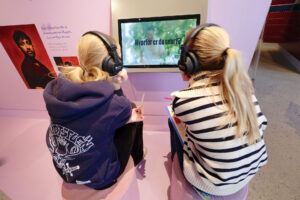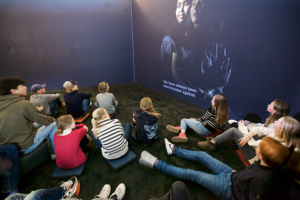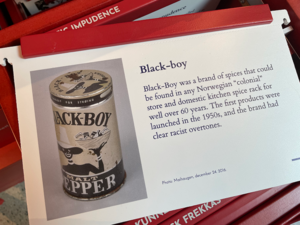HL-senteret
This exhibition focuses on everyday racism and rests on the premise that we need to see and understand everyday racism for what it actually is in order to combat it.

Two young visitors enjoying the humorous monologue ‘Why are you black?”. Photo: Trond Heggelund
Racism is easy to recognise when it leads to violence and extremism. Contemporary everyday racism, on the other hand, can be difficult to spot, particularly for those not directly affected by it.
This exhibition shines a light on everyday racism in Norway today, as described by those with embodied experiences of racism, researchers, and artists. “In/Visible: Everyday racism in Norway” draws on over 50 qualitative interviews with individuals with various minority backgrounds, residing in different parts of Norway.
Through the exhibition, you will encounter:
1. Racism as lived experience
The powerful opening film ‘Loud Skin’ (11 minutes) features 13 individuals who share fragments from their lived experience of everyday racism in Norway, as well as their reflections on how to move forward. You might spot both recurring patterns, and some subtle differences between the different stories.

Enjoy the immersive experience of seeing ‘Loud Skin’, a short film created by Kristoffer Archetti in close collaboration with the Holocaust Centre. (Photo: Trond Heggelund)
2. Racism as words
Here you can see how several researchers attempt to explain what racism is and how it can be measured. Easier said than done? Check out the informational videos where different researchers try to break down complex knowledge about racism into a minute or less! Don’t forget to pick your favourites from the assortment of beautifully designed postcards that sum up some of the most important racism theories.
3. Racism as demonisation
Everyday racism is also digital. The demonisation of minorities is often circulated online. The installation’s exterior wall explains what is meant by demonisation. If you turn the corner, the interior gives you a sensory experience of the internet’s murky side.
4. Audio bench
Sit down, enjoy the view and listen to a variety of excerpts from our interview collection, featuring elements of sadness, happiness & everything in between. Around the corner, you can choose between a humorous monologue and a snappy music video pitched against a wall of colourful photographs. All four installations defy one-dimensional representations.
5. Racism as heritage
Here you can trace the history of racism in Norway through a selection of policies and practices. You can study the contents of four filing cabinets: “Colonial” and “Roles” show the remnants of and break with the colonial view of humanity. Popular culture, in the form of advertising, cartoons and children’s books, has left deep marks. “The State” is devoted to the impact that the policy of Norwegianization has had on the country’s national minorities, while “Norwegianness” looks at everyday racism in an age of globalisation. Open the drawers, take out the documents and immerse yourself.

6. Racism can be combatted
Racism has been met with resistance for decades. Political protest is a familiar method. Here you will see examples of other tactics as well, such as art or the use of humour. Racism can be exposed and opposed in many different and surprising ways.
Language and guided tours
This exhibition is in both Norwegian and English. For most people, guiding is not necessary.
Curators:
Cora Alexa Døving (Research Professor), Mona Abdel-Fadil (Senior Researcher) & Hanne Steien (Head of Exhibitions)
Admission


